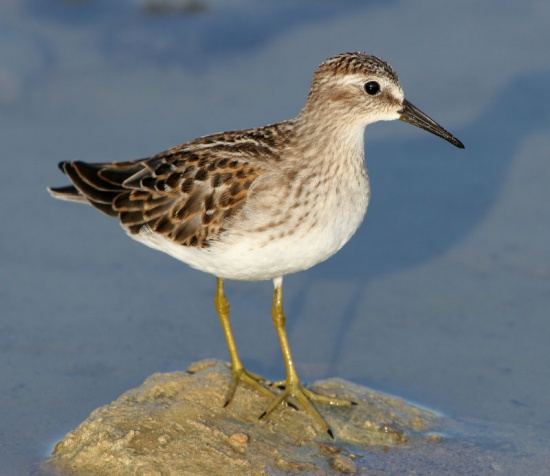m |
|||
| Line 1: | Line 1: | ||
;Calidris minutilla | ;Calidris minutilla | ||
| − | [[Image:Least_Sandpiper.jpg|thumb| | + | [[Image:Least_Sandpiper.jpg|thumb|550px|right|Photo by JonB]] |
==Identification== | ==Identification== | ||
Location: Guelph Lake, Ontario | Location: Guelph Lake, Ontario | ||
| + | The Least Sandpiper, Calidris or Erolia minutilla, is the smallest shorebird. | ||
| + | |||
| + | This species has yellowish legs and a short thin dark bill. Breeding adults are brown with dark brown streaks on top and white underneath. They have a light line above the eye and a dark crown. In winter, Least Sandpipers are grey above. The juveniles are brightly patterned above with rufous colouration and white mantle stripes. | ||
| + | |||
| + | This bird can be difficult to distinguish from other similar tiny shorebirds; these are known collectively as "peeps" or "stints". In particular, Least Sandpiper is very similar to its Asian counterpart, Long-toed Stint . It differs from that species in its more compact, shorter-necked appearance, shorter toes, somewhat duller colours, and stronger wingbar. | ||
| + | ==Distribution== | ||
| + | They migrate in flocks to the southern United States and northern South America. They occur as very rare vagrants in western Europe. | ||
| + | ==Taxonomy== | ||
| + | ==Habitat== | ||
| + | Their breeding habitat is the northern North American continent on tundra or in bogs. | ||
| + | ==Behaviour== | ||
| + | They nest on the ground near water. The female lays 4 eggs in a shallow scrape lined with grass and most. Both parents incubate; the female leaves before the young birds fledge and sometimes before the eggs hatch. The young birds feed themselves and are able to fly within two weeks of birth. | ||
| + | These birds forage on mudflats, picking up food by sight, sometimes by probing. They mainly eat small crustaceans, insects and snails. | ||
| + | |||
| + | |||
| + | |||
==External Links== | ==External Links== | ||
*[http://www.birdforum.net/pp_gallery/showgallery.php?mcats=all&what=allfields&si=Calidris+minutilla View more images of Least Sandpiper in the gallery] | *[http://www.birdforum.net/pp_gallery/showgallery.php?mcats=all&what=allfields&si=Calidris+minutilla View more images of Least Sandpiper in the gallery] | ||
[[Category:Birds]] | [[Category:Birds]] | ||
Revision as of 18:28, 15 June 2007
- Calidris minutilla
Identification
Location: Guelph Lake, Ontario The Least Sandpiper, Calidris or Erolia minutilla, is the smallest shorebird.
This species has yellowish legs and a short thin dark bill. Breeding adults are brown with dark brown streaks on top and white underneath. They have a light line above the eye and a dark crown. In winter, Least Sandpipers are grey above. The juveniles are brightly patterned above with rufous colouration and white mantle stripes.
This bird can be difficult to distinguish from other similar tiny shorebirds; these are known collectively as "peeps" or "stints". In particular, Least Sandpiper is very similar to its Asian counterpart, Long-toed Stint . It differs from that species in its more compact, shorter-necked appearance, shorter toes, somewhat duller colours, and stronger wingbar.
Distribution
They migrate in flocks to the southern United States and northern South America. They occur as very rare vagrants in western Europe.
Taxonomy
Habitat
Their breeding habitat is the northern North American continent on tundra or in bogs.
Behaviour
They nest on the ground near water. The female lays 4 eggs in a shallow scrape lined with grass and most. Both parents incubate; the female leaves before the young birds fledge and sometimes before the eggs hatch. The young birds feed themselves and are able to fly within two weeks of birth. These birds forage on mudflats, picking up food by sight, sometimes by probing. They mainly eat small crustaceans, insects and snails.




